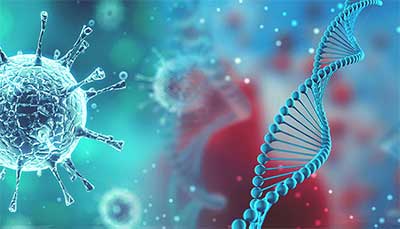Daily-current-affairs
/
01 Nov 2020
D614G Mutation : Daily Current Affairs

D614G Mutation
Why in NEWS ?
- A study involving more than 5,000 Covid-19 patients in Houston finds that the virus that
causes the disease is accumulating genetic mutations named D614G, one of which may have
made it more contagious.
About
- According to the paper published in the peer-reviewed journal mBIO, that mutation,
called D614G, is located in the spike protein that tries open our cells for viral entry.
- During the initial wave of the pandemic, 71% of the novel coronaviruses identified in
patients in Houston had this mutation. When the second wave of the outbreak hit
Houston during the summer, this variant had leapt to 99.9 per cent prevalence.
- This mirrors a trend observed around the world. A study published in July based on
more than 28,000 genome sequences found that variants carrying the D614G
mutation became the globally dominant form of SARS-CoV-2 in about a month.
- It's the largest peer-reviewed study of SARS-CoV-2 genome sequences in one
metropolitan region of the US to date.
- The paper shows "the virus is mutating due to a combination of neutral drift -- which
just means random genetic changes that don't help or hurt the virus -- and pressure
from our immune systems
- It has become the dominant variant in the global COVID-19 pandemic.
- The spike protein is also continuing to accumulate additional mutations of unknown
significance. The Houston Methodist-UT Austin team also showed in lab experiments
that at least one such mutation allows spike to evade a neutralizing antibody that
humans naturally produce to fight SARS-CoV-2 infections.
- The good news is that this mutation is rare and does not appear to make the disease
more severe for infected patients
What is the D614G mutation?
- When the virus enters an individual’s body, it aims at creating copies of itself. When
it makes an error in this copying process, we get a mutation.
- In this case, the virus replaced the aspartic acid (D) in the 614th position of the
amino acid with glycine (G). Hence the mutation is called the D614G.
- This mutated form of the virus was first identified in China and then in Europe. Later
it spread to other countries like the U.S. and Canada and was eventually reported in
India.
How is this mutation different?
- The D614G mutation is situated in the spike protein of the virus.
- You can think of the spike protein as a massive ‘trimer’ assembly with three protein
chains. Each protein chain has two sub-units (S1 and S2). The sub-unit S1 is the one
that attaches to the host cells — Human ACE2 receptor.
- In simple words, this particular mutation aids the virus in attaching more efficiently
with the ACE2 receptor in the human host, thereby making it more successful in
entering a human body than its predecessors.
- To provide a clear picture of how transmissible this particular mutation of the virus
has become over time, a paper in the journal Cell says that the mutation was found
in 10% of 997 global genome sequences before March 1, 67% of sequences between
March 1 and March 31 and 78% of the sequences between April 1 and May 18.
Effects of the mutation
- It discovered that not only did the D614G show increased infectivity but it also
displayed greater ability at attaching itself to the cell walls inside an individual’s nose
and throat, increasing the viral load.
- However, the paper could not establish any direct correlation between this
particular genetic change in the virus and an increase in the severity of COVID-19 or
its impact on a patient’s mortality.
- The patients seem to be exhibiting variable reactions to it depending upon their
genetic constitution, age, exposure to other diseases etc.
- Researchers are still pondering over the effects of this mutation.
How prevalent is it in India?
- The D614G mutation, which is the defining mutation for clade A2 of the virus, is
indeed, quite prevalent in India.
- A study which collected SARS-CoV-2-positive samples from the various States like
Delhi, Tamil Nadu, Maharashtra and Uttar Pradesh among others — reveals that the
D614G was one of the most prevalent spike mutations even during the initial phase
of the pandemic.
- Since then, D614G mutation’s ‘relative abundance’ has increased over time to 70%
and above, in most States except Delhi, reports pre-print in BioRxiv after analysing
samples from 10 Indian States.
Mutation impact on vaccine Research
- A paper in the journal, Nature, after conducting experiments on hamsters, concluded
that this particular mutation may not reduce the ability of vaccines in clinical trials to
protect against COVID-19 and that the therapeutic antibodies should be tested
against the circulating variant of the virus before clinical development.
- There is a need for extreme caution with premature inferences on mutations and
their effects without supporting experimental evidence. This could result in a media
frenzy and potentially undermine public confidence in vaccines.







